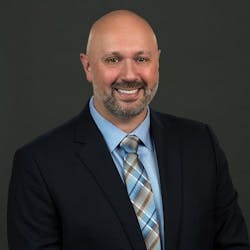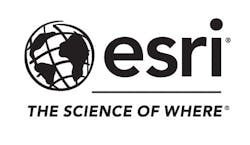Highlights from ISE EXPO 2023 Executive Roundtable
Each year at ISE EXPO, I get to sit down with some of telecom’s brightest thought leaders and strategists and discuss where we are and where we’re headed in the industry. This year, ISE EXPO 2023’s roundtable included executives from Clearfield, Esri, and Future Infrastructure.
The questions and conversations yielded astute observations and wisdom regarding the state of the industry, what still needs to be solved in 2024, and how we can overcome the challenges. It’s the kind of valuable insight that comes from experience, high-level leadership, and unique knowledge. I’m glad to be able to now share with you their thoughts on the supply chain, the workforce, AI, cybersecurity, BEAD, permitting, sustainability, and much more.
“While it's important to deploy broadband quickly, concerns may arise regarding the quality and reliability of the infrastructure. Ensuring that the deployment is done with high-quality equipment and technologies is essential to provide reliable and fast Internet access.” - Denise Manka, Director – Business Development, Future Infrastructure
Topic: Solutions Required
ISE: Share two network-related issues the industry must solve in 2024 that it was unable to remedy in 2023.
Kevin Morgan, Clearfield: Supply chain issues continued to hamper the broadband industry in the first half of 2023 but rather than supply shortages, we experienced excess supply. Hindsight is 20/20 and we now see that the excess inventory was a natural by-product of over-ordering enabled by panic buying after the pandemic. The refrain among buyers sounded like they wanted to make sure they were in the front of the line once the supply shortages abated. However, the bounce back caught buyers off guard and spilled over to excess inventory. We all must be smarter about this in 2024 and beyond.
Lack of skilled labor continues to constrain an otherwise booming industry on the doorstep of historic fiber optic deployment. The limited resource of skilled labor in such a booming market puts the onus on the supplier community to come up with innovative solutions that reduce the need for skilled labor and concentrates on dependable, consistent fiber deployment using state-of-the-art plug and play methods.
Randall René, Esri: The first issue on the forefront of my mind ties to the need for organizations to have comprehensive understanding before acting. Now, more than ever, the critical need for creating a centralized and accurate source of truth for the organization is profound. Creating a comprehensive source of truth not only includes all network mapping, but also includes breaking down walls and connecting siloed datasets contained in legacy OSS and BSS platforms. Through connection to these platforms, organizations can establish a source of truth for all resources teams need for strategic and tactical decision-making. For instance, companies can provide real-time analysis for decision-making, deploy easy-to-use collaborative resources, and communicate accurate and timely information, throughout the organization and with external entities.
The next major issue I see throughout the global telecom industry is the need to transform workflows from reactive to proactive. For example, traditionally, organizations find out about new build properties only months before the first occupancy date. This often leads to unbudgeted capital or expense, negative customer experience, supply chain issues, and unnecessary stress on employees. However, today it is entirely possible to see where homes and businesses will be built years before an organization ever receives a joint-trench notification or address information from a state or local government. In this one example, leveraging GIS and Data organizations can create automated processes designed to provide early warning to the entire organization, allowing for proper planning, forecasting, and engagement.
Denise Manka, Future Infrastructure: With the growing demand for data-intensive applications and the increasing number of connected devices, networks will need to handle larger volumes of data traffic. In 2024, the ICT industry may face the challenge of scaling network infrastructure to meet this ever-increasing demand efficiently. This includes expanding network capacity, improving bandwidth availability, and optimizing network performance to avoid bottlenecks and maintain reliable connectivity.
Cybersecurity threats continue to evolve, and network security remains a critical concern. In 2024, the ICT industry will likely need to focus on developing enhanced network security measures to combat sophisticated cyberattacks, data breaches, and network intrusions. This may involve implementing advanced encryption protocols, strengthening authentication mechanisms, and adopting proactive threat prevention strategies like AI-driven anomaly detection and network behavior analysis.
“Today it is entirely possible to see where homes and businesses will be built years before an organization ever receives a joint-trench notification or address information from a state or local government.” - Randall René, Director Industry Solutions – Telecommunications & Cable, Esri
Topic: Passion
ISE: Share one problem/challenge you are passionate about solving for the ICT Industry.
Morgan, Clearfield: Now, more than ever, the industry needs to put its foot on the gas pedal and go fast. That’s why I’m passionate about speeding up fiber deployments. For example, Clearfield’s FastPass™ methods using in-cassette splicing demonstrate the ability to pass twice as many homes with fiber than older legacy methods. Passing twice as many homes in the same amount of time means the service provider gets twice as many work orders completed in a day. That translates to real ROI for the service provider. At Clearfield, we wake up every day thinking about how we can help our customers remove the barriers to fiber deployment. We do this because we have the vision to enable the lifestyle that better broadband provides. No community should be left behind when it comes to fiber services.
René, Esri: One area I’m passionate about is providing understanding before acting. In telecom, this comes from providing a single source of truth for the organization and comes from unifying OSS and BSS resources. Over the past 20 years, I’ve come to know that the quality of tools and resources our teams leverage in pursuit of daily activities directly impacts successful and timely task completion and affects the satisfaction of both employees and customers. This is because the quality of decisions team members make through organizations are based on the information available at hand. I have heard many times, “I want to eliminate swivel-sharing" or “the process is too cumbersome,” and “we shouldn't have to create this report manually.” When we dig into these statements to learn what drives them, we see they are a symptom of the bigger problem associated with legacy OSS and BSS workflows. These systems are far too often siloed in nature, require standalone interfaces and reports, and numerous other time-consuming and costly workflow requirements.
Manka, Future Infrastructure: Ethical use of Artificial Intelligence (AI) and automation. AI and automation technologies are advancing rapidly, raising concerns about their ethical implications. Issues such as bias in algorithms, job displacement, and the impact of AI on society require careful consideration. Someone passionate about ethics in technology may work on developing frameworks for responsible AI, promoting transparency and accountability in algorithmic decision-making, or advocating for ethical guidelines in the field. While I may not be able to—most likely cannot—solve this by myself, I am passionate about it and feel that this makes connectivity even more important for all, because without the technology connection, our future leaders stand no chance of competing with AI, and they most certainly would be in a lesser opportunity than those who are connected and in a constant learning environment!
Topic: Your Beef with BEAD
ISE: BEAD funding is flowing. What is your greatest concern about BEAD? What’s a solution to that concern?
Morgan, Clearfield: Federal government programs routinely require transparency and long timelines. As of July 2023, significant portions of BEAD funding are not yet flowing. That’s my biggest concern. We have no reason to believe that the BEAD funding and significant flow won’t happen, but it takes a long time. The eligible entities are the States and Territories. They are literally and figuratively “all over the map” when it comes to their readiness. Even the most prepared states do not even expect to begin the service provider selection process until August 2024. So, there’s really no way any business will be coming into the market until 2025. Of course, BEAD is a reimbursement model so, a provider could opt to purchase whatever they want at any time. But that seems unlikely.
René, Esri: Providers throughout the nation are doing what they can to obtain BEAD funding and leverage broadband services to those who need it. One primary question is whether organizations have a sense of the long-term needs and impact of expanded networks. For instance, throughout the world, organizations and governments are working to operate more sustainably and efficiently, while being fiscally responsible and purposeful in their capital investments and overall expenses. With these expanded networks comes a variety of carbon footprint increases with elongated drive times, increase to direct and indirect supply chains, increased power usage, and more. Additionally, with the increased drive times for employees and customers alike, the need for real-time operations metrics as well as advanced analytics for strategic planning, are necessary.
Ultimately, this is a geospatial problem and can be solved with GIS. One example I can share would be drive time analysis associated with rural new build. Having the ability to create an automated high-level design and BOM, then complete a drive time analysis against current fulfillment offices and retail store locations, provides the critical insight and understanding leaders need for strategic and tactical decision-making. With the capability to understand true needs, organizations are best prepared to bid on build areas and understand what it will take to deliver long-term quality of service and experience to consumers while also knowing operational costs and environmental impact.
Manka, Future Infrastructure: I have a few concerns but nothing that can’t be solved with meticulous planning and oversight by the many experts we have in our industry and at the federal wheel:
One major concern is ensuring that the funding is distributed fairly across different regions and communities. There may be concerns about prioritizing underserved or rural areas to bridge the digital divide and provide equal opportunities for all.
Questions may arise regarding how the funds will be managed and whether there will be proper oversight to ensure that the money is being used as intended. Transparency in the selection process, project implementation, and reporting of outcomes is crucial to maintain trust and prevent misuse of funds.
While it's important to deploy broadband quickly, concerns may arise regarding the quality and reliability of the infrastructure. Ensuring that the deployment is done with high-quality equipment and technologies is essential to provide reliable and fast Internet access.
Sustainable funding models and strategies are necessary to ensure that the benefits of broadband deployment are long-lasting. Concerns may include how ongoing maintenance and operational costs will be covered beyond the initial funding period.
“Lack of skilled labor continues to constrain an otherwise booming industry on the doorstep of historic fiber optic deployment.” - Kevin Morgan, Chief Marketing Officer, Clearfield
Topic: Permitting
ISE: Industry leaders have urged Congress to quickly streamline broadband permitting processes. They argue that inconsistent processes, delays, pole attachment, and environmental regulations could slow fiber deployments being funded by BEAD. Share your thoughts about this.
Morgan, Clearfield: Permitting is a partnership between the governmental body and the installer. In this instance, communication is the key. Well-staked rights-of-way along with thorough complete drawings tell the story. The burden is on the service provider to show the plan, stick to the plan, and communicate any changes. Permitting should not be viewed as a revenue source but rather as an investment in the future. The governmental agency cannot be shortsighted when it comes to the long-term benefits of a high-speed broadband network. The permitting process needs to clearly inform the service provider up front on how they should leave the job site during and after construction. Safety requirements must be identified and maintained. Ultimately, the service provider should leave the job site better than they found it. If that happens, everyone wins—the governmental agency, the service provider, and the local residents.
René, Esri: There are a wide variety of roadblocks and hurdles organizations face while working to build out networks. Whether it’s aerial or underground, urban or rural, every location has a variety of entities involved, process requirements, information needs, environmental limitations, and much more that service providers must address in order to connect people to what’s important in their lives. Unfortunately, these factors drive costs upward, customer experience downward, and create frustrating work environments for team members trying to get the job done.
In my role, I see how easy the permitting process could be. I am privy to processes involving permitting entities leveraging GIS working within digital workflows sharing information in real-time with service providers who also leverage GIS. Through leveraging the power of location and GIS, both groups share information seamlessly and in a secure and real-time environment. Additionally, the permitting agency has no paperwork to contend with, they can see all permitting in their region in one view, and they can request more information, approve/deny, or create a collaborative build area when multiple companies wish to build in the same location. The most important part is this all happens with a few clicks.
Manka, Future Infrastructure: Streamlining the broadband permitting process is a topic of interest and importance for many in the telecom industry. The current process and environmental regulations can indeed cause delays in the implementation of broadband projects, resulting in slower deployment and potentially hindering access to high-speed Internet for various communities.
The telecom industry leaders advocating for the streamlining of the permitting process argue that it would help expedite the deployment of broadband infrastructure, reduce administrative burdens, and ultimately enhance connectivity for underserved areas. They believe by simplifying the regulatory procedures, projects can move forward more efficiently and effectively.
However, it's crucial to balance these efforts with environmental considerations and safeguards. Environmental regulations are in place to protect natural resources and ensure responsible infrastructure development. Streamlining the process shouldn't come at the expense of compromising environmental standards or disregarding potential impacts.
About Our Distinguished Leaders
Kevin Morgan is Chief Marketing Officer at Clearfield, joining the company in August 2016. Morgan has served in various senior marketing positions since 1996 at ADTRAN, Inc. where he gained extensive experience in advanced communications technology, fiber optic systems, and business product marketing. Before that, he spent nearly a decade at telephone operating company BellSouth, now a part of AT&T, where he worked as a network engineer and the lead product evaluations resource of broadband technologies in the Science & Technology department. Morgan also served in various industry leadership positions at the Fiber Broadband Association, including three times as the association’s Chairman of the Board of Directors in 2015, 2019 and 2022, after first being elected to the Board in 2010. Mr. Morgan received a B.S. in Electrical Engineering from Auburn University and an MBA from the University of Alabama.
Clearfield, Inc. designs, manufactures and distributes fiber optic connectivity and management products, helping service providers reduce the high costs associated with a fiber optic network to deliver the mobile, residential and business services customers want.
Based on the patented Clearview Cassette, their unique single-architected, modular fiber management platform is designed to lower the cost of broadband deployment and maintenance while enabling our customers to scale their operations as their subscriber revenues increase. Visit them at www.SeeClearfield.com
Randall René is the Telecom Industry Director at Esri, where he is widely regarded as the go-to source on leveraging GIS to deliver transformational workflows designed to improve communication, collaboration, and productivity. He is an international speaker, industry expert, an award-winning volunteer, a veteran, holds an MBA in strategic management, and is currently pursuing his PhD. Randall loves to share insight gained from 25 years in telecom, 14 years as a reserve police officer, time spent volunteering in the community, and love of GIS to help others achieve their best each day. Follow him on Twitter and Linkedin.
Esri, the global market leader in geographic information systems (GIS), offers the most powerful mapping and spatial analytics technology available. Since 1969, Esri has helped customers use The Science of Where to unlock the full potential of data to improve operational and business results. Today, Esri software is deployed in more than 350,000 organizations including the world’s largest cities, most national governments, 75% of the Fortune 500, and more than 7,000 colleges and universities. Esri engineers the most advanced solutions for digital transformation, IoT, and location analytics to create the maps that run the world. Visit them at www.esri.com/telecom. Follow them on Twitter and LinkedIn.
Denise Manka, Director – Business Development, Future Infrastructure, is a highly experienced professional with a diverse background spanning over 20 years in the construction and telecom field. With her vast experience, she has successfully navigated the intricacies of both industries, consistently delivering outstanding results.
Denise has exceptional skills in driving growth and forging strategic partnerships. Her ability to identify new opportunities and cultivate strong client relationships has been instrumental in expanding her business portfolio. Under her leadership, Denise's team consistently surpassed targets and achieved remarkable revenue growth. Her influence extends beyond her immediate team. She has established a prestigious think tank comprised of top industry influencers who convene monthly to collaborate on cutting-edge trends and explore opportunities in the ever-evolving market. This network has not only strengthened her own business acumen but has also allowed her to stay ahead of industry developments and offer innovative solutions to her clients.
Known for her professionalism and business acumen, Denise approaches every situation with a thoughtful and strategic mindset. Her dedication to excellence and commitment to delivering high-quality results have earned her the respect and trust of colleagues and clients alike.
Outside of her professional pursuits, Denise is an advocate for community engagement and philanthropy. She actively volunteers with local organizations, supporting causes related to education, homelessness, and environmental conservation. Her commitment to making a positive impact extends beyond the boardroom, as she believes in leveraging her skills and resources to create a better future for both individuals and communities.
With her wealth of experience, leadership abilities, and extensive professional network, Denise Manka continues to make significant contributions to the construction and telecom industries, driving growth, and shaping the future of these dynamic sectors.
Future Infrastructure, a Primoris Company, is a leading communications infrastructure specialty contractor offering program management, construction, and maintenance services to the leading communications companies across U.S. markets. As communication technologies rapidly evolve and the service base expands, Future Infrastructure is committed to growing 5G network deployments and supporting the transition to fiber optic systems to meet the industry’s growing demand. Visit them at www.prim.com/about/business-units/future-infrastructure.
About the Author
Janice Oliva
VP, Event Business Development, Endeavor Business Media
Janice Oliva is the VP, Event Business Development for Endeavor Business Media. Her primary focus is to develop a comprehensive content strategy for all EBM events that align with the event’s overall goals and objectives and roll out new event launches. Previously, Oliva was VP, Group Publisher Lighting & Digital Infrastructure at EBM and the owner of ISE and ISE EXPO prior to selling to EBM. She has worked with several magazine publishers since 1991 including PCI, Thompson Financial, The Aberdeen Group and Mpls./St Paul Magazine. Oliva has a bachelor’s degree in Communication Studies from the University of Iowa. She resides in St. Petersburg, FL, with her husband and two dogs along with their college age children, Mario and Sydnie, when they come home for rare visits.
![[L to R] Kevin Morgan, Chief Marketing Officer, Clearfield; Denise Manka, Director – Business Development, Future Infrastructure; Randall René, Director Industry Solutions – Telecommunications & Cable, Esri [L to R] Kevin Morgan, Chief Marketing Officer, Clearfield; Denise Manka, Director – Business Development, Future Infrastructure; Randall René, Director Industry Solutions – Telecommunications & Cable, Esri](https://img.isemag.com/files/base/ebm/isemag/image/2023/12/656a322d6e793d001ee84365-thu_5283.png?auto=format,compress&fit=fill&fill=blur&q=45?w=250&width=250)
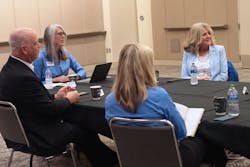
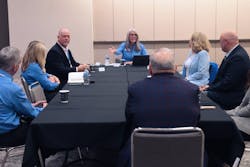
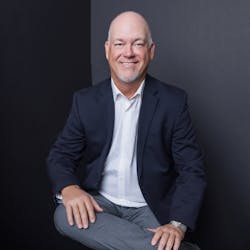
![Clearfield Logo Stackedno Tag(ill 9) [converted] Clearfield Logo Stackedno Tag(ill 9) [converted]](https://img.isemag.com/files/base/ebm/isemag/image/2023/10/ClearfieldLogo_stackedno_tag_ill_9___Converted_.6526c8cfc1237.png?auto=format,compress&fit=max&q=45?w=250&width=250)
